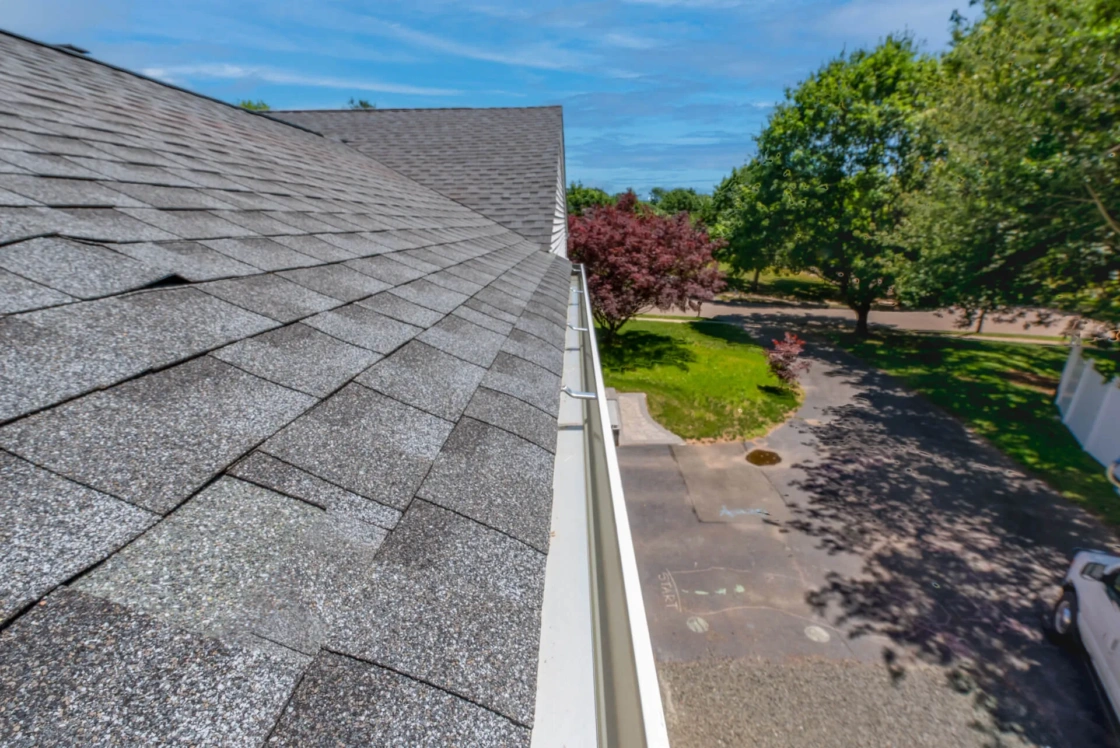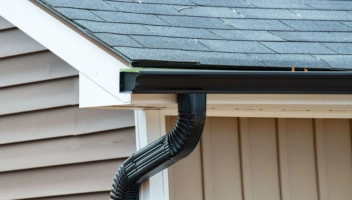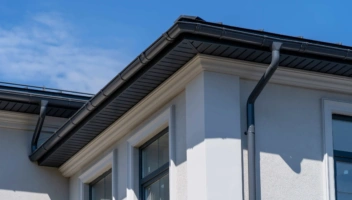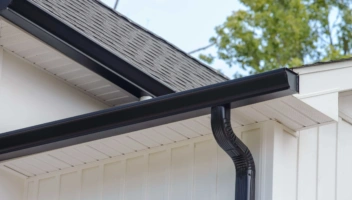Gap Between Roof and Gutter: Causes, Fixes, and Prevention

A gap between the drip edge of your roof and the gutters can quickly escalate into a costly problem for homeowners. A gap may be the outcome of heavy debris buildups, snow or ice damage, improper installation, or simply the natural settling and expansion over time that causes them to separate from the roofline.
Gaps between the roof and gutter can have consequences that go beyond water damage. When gaps allow water to bypass gutters, it can pool around your foundation, seep into walls, or cause basement flooding. These openings can also create entry points for pests looking for shelter. Gaps can compromise the structural integrity of your roof and allow water that freezes and then thaws, causing wood to deteriorate and shingles to loosen. In this guide, you’ll discover how to identify roof-to-gutter gaps and learn quick fixes and permanent solutions to help prevent roof drainage issues or expensive, avoidable home repair.
What is the Roof-to-Gutter Gap?
A roof-to-gutter gap refers to the space that can exist between the gutter system and the edge of the roof. While this space may seem small and insignificant, it’s an area that can make or break your water management system. The key to proper drainage is maintaining the ideal spacing between the gutter and the drip edge. Ideally, your gutter is situated underneath the drip edge, with the drip edge slightly overlapping the back of the gutter.
Gaps larger than recommended run the risk of water overshooting the gutter and getting behind fascia boards, which can cause erosion, rot, and mold growth. Correct spacing is crucial for making sure water flows properly from the drip edge to the gutter system, reducing leaks, debris buildup, and lowering the risk of overflow. Gaps carry additional risks when it comes to unwanted guests. They provide space for critters, rodents, and insects to make a home, putting your insulation and wiring at risk, which could lead to costly repairs.
Recommended Gap Measurements
Model codes don’t specify a roof-to-gutter gap. Instead, they require drip edge flashing and set how it’s installed. Major shingle manufacturers call for shingles to extend roughly ¼”–¾” past the drip edge, with the shingle edge overhanging the inside edge of the gutter to direct water into it
Depending on what climate you live in, slightly wider gaps may be necessary to help prevent swelling and maintain airflow in areas with high humidity and heavy rainfall. Arid climates can stay near the minimum gap, as there is less moisture to worry about. The recommended gap can vary for steeper roofs, where water will run off quickly. Flat or low-slope roofs may benefit from closer to a ¼” gap to ensure proper drainage.
Setting up gutters and the roof-to-gutter gap correctly can be the difference between proper water drainage and costly repairs.
| Aspect | Correct Setup | Incorrect Setup | Inspection Cue |
|---|---|---|---|
| Gap Size | 1/4″ | Gaps too tight or no gap at all | Check to see if panels are touching or if there’s visible space |
| Alignment | Uniform spacing | Uneven or random spacing | Check for gaps running parallel and watch out for offset edges |
| Water Flow | Proper drainage with no buildups or pooling | Water leaks or gets trapped | Beware of any mold, rotting, or water stains |
| Movement | Panels have space to expand and contract | Panels buckling from a lack of space and moisture expansion | Watch out for warping, lifting, or cracking in panels |
| Fasteners | Proper placement, not bridging gap | Nails/screws pinning edges | Fasteners too close to gap line |
Why It’s Important to Fix the Gap Quickly
If you’ve identified a roof-to-gutter gap that exceeds industry guidelines or building recommendations and have started to see trouble, it’s best to act fast. It doesn’t take long for water leaks to damage fascia and soffits as these wood components absorb moisture and begin to deteriorate quickly. If water seeps behind them, it can cause rot and mold, which over time can weaken roof edges and lead to expensive repairs. Foundation and structural risks can also result from incorrect gutter gaps, as misdirected water pools around the foundation saturating the soil and leading water into basements through cracks.
Gaps that are too large can leave important areas of your home exposed and provide space for rodents, birds, and insects to build nests. They can also compromise insulation and wiring, leading to complicated removal and extensive fixes.
When it comes to energy efficiency, gaps allow air leaks that reduce insulation performance, raise heating and cooling costs, and create uncomfortable indoor environments. A gutter gap left unattended will worsen over time and lead to gutter misalignment, creating uneven water flow, which accelerates wear on gutters and causes overflow that can damage siding or even landscaping.
What Causes a Gap Between Roof and Gutter?
Some homes are designed with a builder’s gap or roof shingle overhang. Other gaps could be a sign your gutters were installed incorrectly. Sometimes it’s the roofline or fascia issues causing problems. Understanding what causes gaps between the roof and gutter can help inform whether it’s time to start planning for repair.
- Builder’s Gap or Roof Shingle Overhang: Some builders leave a small space where the shingles extend past the fascia. This extension still directs water to the gutter. However, if the overhang is too long or the gutter sits too low, water can overshoot and cause problems. This is often by design, but if you notice water overshooting or water stains on walls, it should be corrected.
- Incorrect Gutter Installation: Gutters mounted too low can create an unwanted gap between the roof edge and the gutter. Brackets that are misaligned or poorly attached can also pull gutters away from the fascia.
- Sagging or Loose Gutters: Gaps can be caused by debris that leads to standing water or ice buildup, which causes sagging over time. Cleaning out gutters regularly can help prevent sagging. Loose gutters are often the result of poor fastening, which causes them to pull away from the roof. If you notice loose or sagging gutters, fix quickly by cleaning out gutters or reattaching where needed.
- Roofline or Fascia Issues: Fascia or roofline issues, such as warping, rot, or shifting wood, can disrupt gutter alignment and create unwanted gaps. These are serious issues that need to be repaired immediately before fixing gutters.
- Weather Damage: Heavy rain, snow, or storms can tug on gutters and loosen fasteners, and small gaps can quickly grow into larger issues. Check for damage after storms and repair any loose sections fast to help prevent costly water damage.
How to Inspect and Measure Your Roof-to-Gutter Gap
Inspecting your gutters starts with a ground-level inspection: walk around your home and survey your gutters. Be on the lookout for sunlight peeking through the gutter line and the roof, which could indicate roof and gutter separation. Check for any signs of water damage or leaks onto the fascia, or if the gutters are sagging or buckling.
For a closer look, a ladder may be necessary. If you choose to use a ladder, be sure to place the four feet on even ground, have a spotter nearby to help and hold the ladder, and follow safety precautions with both hands and feet on the ladder at all times. From the ladder, you can check gutter alignment and inspect the drip edge to help ensure it overlaps correctly. Use a ruler or tape measure to measure gaps at several points throughout your inspection.
During the ground-level and ladder inspection, look for signs of damage such as water stains, rot, peeling paint, or pools of water at the foundation. If your inspection leads to the discovery of severe rot, leaks, and forming foundation issues, it’s time to call in professional services such as LeafFilter, as their expert gutter pros can repair misaligned gutters and recommend long-term solutions.
How to Fix a Gap Between Roof and Gutter
Fixing roof and gutter separation isn’t always straightforward. You could be dealing with a complex roof design, steep elevations, or structural issues that can make the repair risky. It’s always best to conduct a thorough examination of the situation and clean out gutters before getting started. You can tackle minor gaps with sealant or attempt to fix them by installing or adjusting the drip edge. In other cases, realigning or reinforcing gutters with screws can be enough. More extensive repairs could mean completely replacing damaged fascia boards or relying on professional services to get the job done.
Using Sealant for Minor Gaps
A high-quality exterior-grade caulk or sealant can be applied to keep water from getting behind the gutter. You’ll want to select a sealant designed specifically for roofing and gutters. We recommend a paintable sealant with UV resistance. This works when gaps are small and non-structural.
Installing or Adjusting the Drip Edge
A drip edge is a metal flashing installed along the roof edge to guide water into the gutter. If missing, install it by sliding it under the shingles at the eaves, letting the angled edge hang slightly past the fascia, then nail it every 8–10 inches. For a water-tight fit, overlap sections by 2 inches minimum. To adjust the drip edge, loosen or remove the nails holding it and carefully lift the shingles to reposition it. Once it’s in place, re-nail and replace shingles.
Realigning or Reinforcing Gutters
Loose or sagging gutters can be fixed by reattaching them with screws, adding hidden hangers, and adjusting the pitch for proper drainage. Use a level to confirm the correct slope (about ¼” drop for every 10 feet of gutter), then secure the hangers or screws tightly along the fascia to hold the gutter in its new position.
Replacing Damaged Fascia Boards
When rot or deterioration has caused the gutter to pull away, the fascia board may need to be replaced. Start by removing the old section, then replace it with a new primed lumber. Repaint and seal the lumber before reattaching the gutter.
Professional Repair or Replacement
DIY methods run the risk of serious injury and failure to complete the repair correctly, leading to increased expenses for more damage and reactive repairs down the road. Professionals have access to the proper tools and equipment paired with the ability to follow installation best practices. LeafFilter’s gutter repair services are designed to help protect your foundation, roof, and landscaping from costly issues.
Preventive Measures to Avoid Future Gutter Gaps
With regular roof and gutter maintenance, you can keep gutter systems functioning properly and spot issues such as gutter misalignment early. Seasonal maintenance—cleaning out your gutters at least two times a year after the fall leaf drop and before the spring showers—is recommended. In climates with heavy snowfall or rain, additional cleaning before storms may be necessary, since excess debris or ice can quickly block water flow and worsen gutter gaps.
Additionally, consider installing micro mesh gutter guards to reduce clogs, helping to keep your gutter gap in check.
For long-term protection against water seepage, ensure the drip edge is functioning properly and is positioned to direct water into the gutter. Finally, schedule an annual or bi-annual professional inspection to catch early signs of gutter misalignment or fascia board damage before they lead to costly home improvements.
Maintaining Your Roof-to-Gutter Gap: Final Thoughts
Safeguarding your home’s fascia, siding, foundation, and energy efficiency starts with maintenance. By conducting regular on-the-ground inspections and hiring professionals for annual maintenance, you’re taking proactive steps to help prevent roof drainage issues. Now that you know what causes roof-to-gutter gaps and how to address them—from sealing minor spaces to installing a drip edge—you can also stay ahead of potential gutter misalignment.
For personalized guidance or to create a plan that keeps your gutters functioning for years to come, consult with LeafFilter gutter experts today.
Frequently Asked Questions
How often should I check the roof-to-gutter gap?
You should check your roof-to-gutter gap at least twice a year, in the spring and fall, or more often if you live in climates with heavy rainfall or have dense tree coverage near your home. Look out for warning signs such as sagging gutters, water stains on fascia, peeling paint, or pooling water near your foundation, which can indicate immediate adjustment is needed.
Can I adjust the gap myself?
While minor gaps can be adjusted in a DIY fashion, using a ladder always carries risk, and roof work can be dangerous. Tackling widespread misalignment can be a serious time commitment. If you’re making adjustments on your own, you risk over-tightening fasteners or miscalculating the slope, which can lead to even bigger problems. If you notice rotting in fascia or structural issues, it’s best to call a professional.
How does the gap affect gutter guard installation?
When the gap is within the recommended range, guards sit flush against the roof edge and allow water to flow smoothly into the gutter while letting leaves and debris slide off the roof. The gap-to-gutter alignment is important for ensuring the guard doesn’t flex or create openings for debris to accumulate.
If the gap is too wide, gutter guards may not sit properly, causing water to overflow during heavy rain. If the gap is too tight, guards will bow upward, creating areas where debris collects or water pools instead of draining. Before having gutter guards installed, check gutter alignment, adjust the pitch if needed, and confirm that the gap is even along the roofline to maximize guard performance season after season.
Will climate affect my roof-to-gutter gap?
Yes, seasonal temperature shifts, freeze-thaw cycles, and heavy snow or rainwater can cause gutters to shift slightly over time, widening the gap. Seasonal checks and gutter cleaning are important to help prevent buildups of debris or clogs. Making checks after severe weather will help you catch any shifts early and make adjustments before they snowball into bigger problems.


